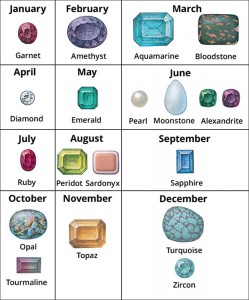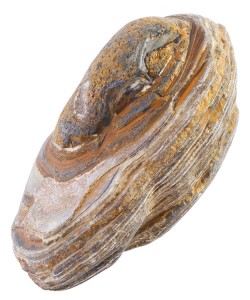The Birthstones of August
Monday, August 19th, 2019August 19, 2019
If your birthday is in August, you have two birthstones—the gems associated with the month of your birth: peridot and sardonyx. Peridots are a variety of a common rock-forming mineral called olivine. A high iron content gives peridots their distinctive green color. The sardonyx is a multi-colored variety of chalcedony, a fine-grained form of the mineral quartz. Most sardonyx has straight or slightly curved bands of reddish-brown and white. Both peridot and sardonyx have long been used in jewelry and decorative objects.

Peridot is one of two August birthstones. The other is sardonyx. Credit: © Albert Russ, Shutterstock
Peridots have been known since Biblical times, and legend says the stones improve health, guard against insanity, and slow the human aging process. Peridots are also said to increase assertiveness, patience, and clarity of thought and to encourage prosperity and happiness. Jewelers cut and polish the highest-quality peridot stones so that each gem has many flat surfaces called facets. Faceted peridots are used in all types of fine jewelry. Jewelers cut lesser-quality peridots into a rounded style called cabochon or polish them with abrasives in a process called tumbling. These lesser-quality peridots are used in costume jewelry and decorative objects. The earliest source of peridots was Jazirat Zabarjad (St. John’s Island), off the Egyptian coast in the Red Sea. In the United States, Arizona and New Mexico are important commercial sources of peridots.
In ancient Egypt, sardonyx was considered a protective stone, and it was used to ward off evil. Modern folklore credits sardonyx with encouraging confidence, creativity, happiness, integrity, optimism, and even virtuous behavior. It is said to help students preparing for exams, authors dealing with writers block, or anyone faced with a job requiring mental discipline. Jewelers usually cut sardonyx flat or with a domed shape to bring out the bands of color. Cameos (engraved gems) are sometimes cut from sardonyx to take advantage of its color. The chief sources of sardonyx are Brazil, India, and Uruguay.

Click to view larger image
Birthstones, according to tradition, bring good luck when worn by a person born in the associated month. Credit: WORLD BOOK illustrations by Paul D. Turnbaugh
According to tradition, a birthstone brings good luck to a person born in its month. Each birthstone also corresponds to a sign of the zodiac. The belief in birthstones may have come from a Bible story about Aaron, the first high priest of the Israelites. The story describes Aaron’s breastplate, which was decorated with 12 precious stones. Early writers linked these stones with the 12 months of the year and the 12 signs of the zodiac. The custom of wearing a stone that represented a person’s zodiac sign probably originated in Germany or Poland in the 1700′s.



